
Meet Hamilton’s team in Rio
By Steve Milton, Hamilton Spectator
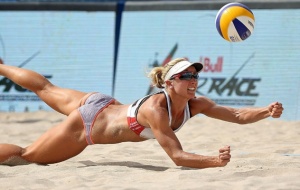
Heather Bansley
Beach volleyball
Born: Sept. 13, 1987
School: Waterdown District, University of Toronto
Heather Bansley
Beach volleyball
Born: Sept. 13, 1987
School: Waterdown District, University of Toronto
Bansley was a five-time Ontario university all-star, two-time all-Canadian and Ontario player of the year and also led the nation in kills and aces and points-per-set when she played for the Varsity Blues.
At the suggestion of her coach Kristine Drackich, Bansley began evolving into a beach volleyball player in the summer of 2007, three years before she graduated from U of T. She started competing fulltime on the elite FIVB Beach Volleyball World Tour in 2010 and, partnering with Liz Maloney, won two of the three matches over Mexico to land Canada a women’s-team berth for the London 2012 Olympics. But she and Maloney were forced to play a one-match winner-take-berth event, which they lost to Quebec’s Annie Martin and Marie-Andree Lessard.
That, according to her Olympic team bio, left her determined to never leave qualifying to chance again.
Bansley teamed with Sarah Pavan, from Kitchener, following Maloney’s retirement due to a knee injury in 2013. Despite their short time together, they are now Canada’s top team and stand fifth overall in Olympic rankings. They enjoyed a superb 2015 season, with their first World Tour podium finish (second) at Prague and became the first Canadian women’s team to win an FIVB Major Series medal with a silver in Porec, Croatia. Bansley completed the season as the top scorer in Major Series events and she and Pavan finished fifth at the world championship, the best-ever by a Canadian pair. This season Bansley and Pavan have won a bronze at the Moscow Grand Slam and silver again at Porec.
Canada has qualified the maximum two women’s and two men’s teams, for the first time since the ultra-popular sport debuted at the 1996 Olympic Games in Atlanta. Bansley and Pavan are considered medal contenders.
“When we are playing to our potential, we are up there with the best teams in the world,” Bansley told CBC.
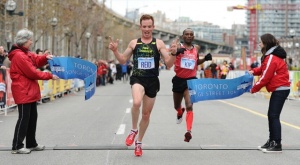 Reid Coolsaet
Reid Coolsaet
Marathon
Born: July 29, 1979
School: Westdale Secondary, University of Guelph
Last fall, Reid Coolsaet ran the fastest marathon by a Canadian in 40 years to cap a 2015 season that “was the best year ever for me.” He had already reached the qualifying standard for the Rio Olympics a few months earlier at a marathon in Rotterdam and turned in a time of two hours, 10 minutes and 28 seconds at the Berlin Marathon, in September 2015. That’s just 19 seconds off the oldest record in Canadian athletics, which Jerome Drayton sat at the Fukuoka Marathon in Japan in late 1975.
This past winter, however, Coolsaet suffered a nerve impingement in his lower spine which tightened his hamstrings and gluteus maximus and at one point he felt the injury might threaten his trip to Rio. But Coolsaet demonstrated Olympic-level fitness in winning the Ottawa 10K (which also gave him the Canadian championship) and finishing second to friend and training partner Eric Gillis at the Toronto Waterfront 10K so he will be on the starting line on the final day of the Rio Games, his second Olympics. He was 27th in 2012 on a very muggy day in London.
Coolsaet got married in June and he and his wife Marie moved into their house in Hamilton in July. He says that if his recovery from Rio goes well he might be able to run a late fall marathon to try to break Drayton’s record.
He feels going to a second Olympics will help him in dealing with outside factors such as the extra media attention, “I think the second time around I kind of know what to expect,” he says. “At my first Olympics I felt pretty normal, though. I hadn’t been to an Olympics before but I’d been to world championships and the field was the same. As far as the starting line goes, it didn’t feel different.”
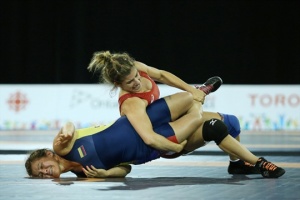 Michelle Fazzari
Michelle Fazzari
Wrestling, 58 kg
Born: July 10, 1987
School: Cayuga Secondary School, Brock University
Born in Hamilton, Fazzari won a provincial high school championship for Cayuga a couple of years after taking up wrestling on a dare. She got into the sport seriously when she attended Brock and won three gold medals at the CIS championships and competed at the 2008 world university championships.
Her first international experience came in 2006 when she won silver at the Pan American junior championships and bronze at the Pan Am senior championships. She also placed in the top 10 in the world championships in 2012, ’14 and ’15, and has been ranked as high as second in the world. She won the gold medal at the 2013 Jeux de la Francophonie.
She made her first national team despite shoulder surgery two years earlier that doctors felt would end her wrestling career. And last summer she competed at the Pan Am Games just three weeks after she had knee surgery and was unable to continue after her first match. But heading into the Olympics she’s had an excellent season, qualified for the Olympics — she was in London in 2012 as a training partner for medallist Tonya Verbeek — and hopes to contend for a medal in Rio.
“You don’t just want to go to the Olympics,” she told The Spectator’s Scott Radley. “You want to do well.”
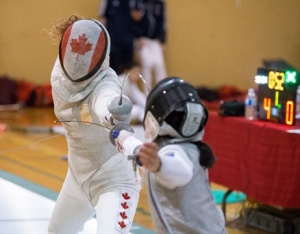 Eleanor Harvey
Eleanor Harvey
Fencing, individual foil
Born: Jan. 14, 1995
School: Westdale Secondary; Ohio State
Although she is one of the younger members of Canada’s Olympic team, Harvey is loaded with experience at the world level. She won silver medals in foil at both the 2014 and 2015 world championships. She has fenced at two Pan Am Games and was seventh in individual foil at last summer’s Games in Toronto while contributing immensely to Canada’s upset of the favoured U.S. for the team gold medal by winning the last match in overtime.
In March, Harvey, now heading into her senior year at Ohio State University, won the NCAA (U.S. college) championships with 21 victories in 23 round-robin matches and dominant performances in the medal rounds. She had been ninth last year.
An all-round athlete, she was a sprinter when she was younger and then switched to karate before concentrating on fencing, which she started at the age of 10.
Harvey had originally set her sights on the 2020 Olympics, when she would have an extra four years experience. But when her 2015-16 season got off to a good start she told herself, “All right, I’m going to go for it.”
“The Olympics have always been my goal,” she says. “All my life.”
 Kia Nurse
Kia Nurse
Basketball, guard
Born: Feb. 22, 1996
School: St. Thomas More; University of Connecticut
Although she’s the youngest member of the Canadian women’s basketball team, Nurse has already made a huge impact on the national program. In 2012 she captained Canada’s team to a bronze medal at the u-17 world championship and the next year made the senior team, helping them to a berth in the 2014 world championships where they finished fifth, Canada’s best result in 28 years.
Her 33 points against the heavily favoured U.S. when Canada won the gold medal at last summer’s Pan Am Games is the stuff of legend and led to the Canadian Olympic Committee naming her as flag bearer for the closing ceremonies. Last August she averaged 13 points per game in the FIBA Americas Olympic qualifying tournament, where Canada secured a berth for Rio nearly a year before the Games.
Nurse is from a prominent Hamilton athletic family. Her father Richard played for the Tiger-Cats and her mother Kathy played basketball at McMaster. Her older brother Darnell plays for the NHL’S Edmonton Oilers and her older sister Tamika was on the junior national team and played at the University of Oregon. Nurse led St. Thomas More to three provincial basketball titles and her UConn team has won the NCAA title in both of her two years there.
“We won’t be shy to tell you the goal is to come home with a medal,” Nurse says of the Rio Games. “We understand we have to peak at the right time, but we have the potential, and the sky’s the limit.”
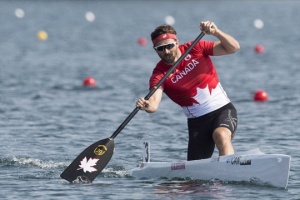 Mark Oldershaw
Mark Oldershaw
Canoeing (C-1), 1000 metres
Born: Feb. 7, 1983
School: Burlington Central; Carleton University
The fifth member, and third generation, of Canada’s First Family of paddling to compete at the Games dating back to grandfather Bert at London in 1948, Mark became the first Oldershaw to come home with an Olympic medal when he won bronze in a stirring C-1 race — at London, no less — in 2012. He had Bert’s paddle with him at the time, although it will remain at home for Rio.
Oldershaw broke onto the global scene by winning both the 500 and 1000 metre C-1 events at the 2001 junior world championships, and his grandfather gave him the paddle afterwards. His father Scott, who competed at Los Angeles in 1984, is the coach of both Oldershaw and close friend Adam van Koeverden. This will be the two friends’ third Olympics together.
At last year’s Pan Am Games, Oldershaw was Canada’s flag bearer for the opening ceremonies and he went on to finish second in the C-1 event at the Welland flatwater course. He is married to former Olympic swimmer and 2009 world silver medallist Annamay Pierse, and they have a year-old daughter, Josephine.
“It’s not something you think about on the start line by any means,” he says of the family’s paddling history. “But there’s definitely a sense of pride knowing what they’ve done and knowing the heritage there.”
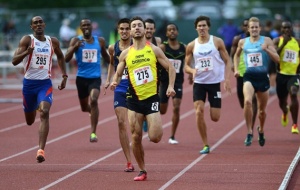 Anthony Romaniw
Anthony Romaniw
Track, 800 metres
Born: Sept. 15, 1991
School: St. Thomas More; Dartmouth; University of Guelph
Having already met the qualifying standard time, Romaniw had to finish second at the Canadian track and field championships and Olympic trials in Edmonton earlier this month and did so by edging fellow Hamiltonian Robert Heppenstall for second place.
Nicknamed “Tony Romo,” Romaniw was 13th at the 2010 World Junior championships, seventh at the 2013 World Universiade after posting the fastest time in qualifying heats, and finished 15th at last summer’s Pan Am Games in Toronto. He won the gold medal over 600 metres and took silver in the 800 metres at the 2013 CIS (national university) championships to help Guelph to the team title.
The 800-metre event, the shortest of the “distance” races, is one of the most difficult to train for because it involves both sprinting and distance pacing.
“With the exception of a few, on any given day anybody can beat anybody in the 800,” he says. “I think if I run the prelims well, I think I can make it to the semifinals. I’d like to get to the finals and then, in the 800, anything can happen.”
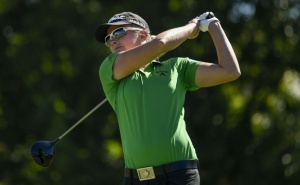 Alena Sharp
Alena Sharp
Golf
Born: March 7, 1981
School: Westdale Secondary; New Mexico State
Golf makes its return to the Olympics for the first time since Canadian George S. Lyon won the men’s event at St. Louis in 1904. But women’s golf has been absent since 1900 when Americans swept the podium the only time it’s been an Olympic event for women. No Canadian team was in the 1900 event, so Sharp and Smith Falls’ Brooke Henderson comprise the first Canadian women’s golf team.
Sharp says that playing on the LPGA tour with the 18-year-old Henderson has “brought out the fearless kid in me” and she’s had two of her best seasons in 2015 and ’16. Three of her seven top-10 finishes on the top women’s pro tour have come in the past season and a half. Sharp, who tries to wear patriotic red and white in her final round, is a three-time Canadian women’s PGA champion.
Canadian golf coaches are among the few who have already been to Rio to scout and map the new course that will be used for the Olympics, which should give Canada an advantage in the early going. Sharp also hits long off the tee, a favourable asset for the Olympic course, and has been practising regularly in the wind because the course is windswept.
“It’s a huge honour to represent Canada and to go down there and really represent women in the sport of golf,” she says. “And hopefully we can spur on more girls to play.”
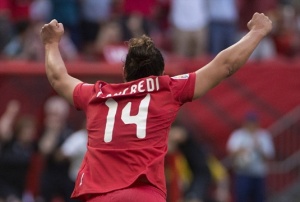 Melissa Tancredi
Melissa Tancredi
Soccer, striker
Born: Dec. 27, 1981
School: Cathedral; University of Notre Dame
Melissa Tancredi is a legend and longtime role model in international women’s soccer, and a constant thorn in the side of Canada’s most bitter rivals — the U.S.
The Ancaster native is one of only six returning players from the 2012 women’s Olympic team that caught all Canada’s attention at the London Games, first with a rousing, controversial 4-3 loss to the U.S. in the semifinals, followed by the redemptive 1-0 victory over France in the bronze medal game. Her four goals in the group stage tied her for the early lead in the Olympic tournament. She set up two of Christine Sinclair’s three goals against the U.S. in what is considered the greatest women’s game ever played, and drove the American players to distraction with her tenacious physical play.
Tancredi has been one of the most identifiable players on the senior team on a regular basis since 2007. She has also played in three World Cups for Canada. As an all-American she led Notre Dame to an NCAA title, won a bronze medal in the 2007 Pan Am Games, and last June she earned her 100th cap when Canada played England in a friendly before a sold-out Tim Hortons Stadium crowd right in her hometown.
She returned to the national team in 2014 after two years off to finish her chiropractic studies and after the Games will go back to her team in Sweden, the ninth team for which she has played professional football.
“She’s played at the highest level consistently for the last 10 years,” says coach John Herdman. “She’s still in great physical shape and has a great deal of experience on the international stage in tournaments. With that sort of passion and enthusiasm she brings to the environment, for me it’s a no-brainer.”
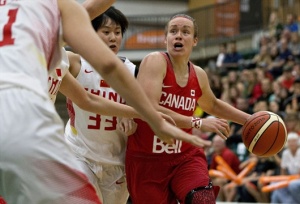 Shona Thorburn
Shona Thorburn
Basketball, guard
Born: Aug 7, 1982
School: Westdale Secondary; University of Utah
The senior member of the women’s national team, Thorburn was born in England but moved to Canada with her family when she was 11. By the time she was 16 she was playing for the country at the 1998 World Youth Games. In 2002 she made the senior national team, and played in the 2003 Pan Am Games.
She starred at Utah, starting every game in her four varsity seasons, and led the team to the Elite Eight in her senior year when she was drafted seventh overall by the WNBA Minnesota Lynx. She spent parts of two seasons in the WNBA with the Lynx and Seattle Storm, then went to Europe in 2007 to play pro basketball, first in Spain and then in France, where she is still playing for Nantes Rez.
Thorburn was absent from the national team program for a number of years before returning in 2011 for the FIBA Americas tournament, in which Canada won bronze. At the next FIBA Americas, in 2013, she helped Canada to a silver medal and last year the team won gold, qualifying for Rio much earlier than it did for London, where Canada had to win a berth at a last-chance qualifier only a month before the Games. She led Canada in assists in three of the five games as Canada reached the quarter-finals. She broke her leg at last year’s FIBA Americas tournament and had surgery in late August but is back playing strong, intelligent basketball.
“It’s been very different in the regard that we’re getting attention this year,” Thorburn says of the 2012 and 2016 Olympic teams. “It’s great. It’s more of a ride this time around.”
Updated on Tuesday, August 02, 2016.

